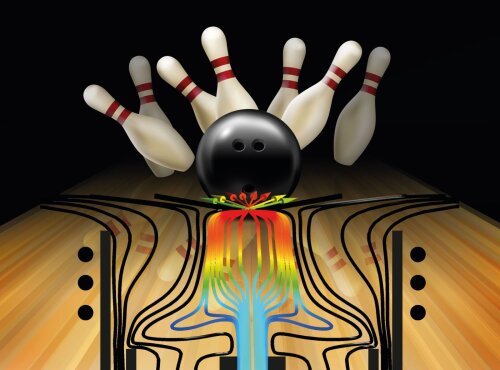Plasma is also used in analytical chemistry, and in the past, we developed several models for different types of plasmas used for this application. The most popular type of plasma for this application is the inductively coupled plasma (ICP) operating at atmospheric pressure, typically in argon. It is routinely used for the analysis of various types of samples, in liquid, gaseous or solid state (the latter in combination with special sample introduction methods, like laser ablation of a solid material). When the sample to be analysed is introduced in the plasma (as aerosol, liquid or solid particles), it will be subject to desolvation, vaporisation, ionisation and excitation. The ions created in this way can be measured with a mass spectrometer (ICP-MS), while the characteristic photons, emitted by the excited species, can be detected with optical emission spectrometry (ICP-OES). Another popular type of plasma for analytical chemistry is the glow discharge (GD), typically operating at reduced pressure, again mainly in argon. It can be operating either in direct current (dc), radio-frequency (rf) or (millisond or microsecond) pulsed mode. It is also routinely used, but mainly for solid sample analysis, including thin film and depth profiling analysis, again in combination with MS or OES (GDMS, GD-OES). The solid sample typically functions as the cathode (or powered electrode, in case or rf) of the GD plasma, and is being sputtered by energetic plasma ions and atoms. The sputtered atoms arrive in the plasma, where they will be ionised and excited. In recent years, the GD is also gaining interest for the analysis of liquid and gaseous analysis, using various types of source designs, typically operating at atmospheric pressure, and in combination with MS (commonly called ambient MS).
We have developed comprehensive models for a glow discharge in dc, rf and pulsed operation mode. These models are hybrid models, composed of several Monte Carlo, fluid and collisional-radiative models. Furthermore, we also developed fluid dynamics models for laser ablation, focussing on laser-solid interaction, plume expansion and plasma formation, as well as the gas dynamics in a laser ablation cell. Finally, we developed fluid dynamics models for sample introduction into the ICP, including evaporation, ionisation and excitation.

Key publications
Modeling plasmas in analytical chemistry - An example of cross-fertilization.
A. Bogaerts
Anal. Bioanal. Chem., 412, 6059-6083 (2020) (Invited feature article in the topical collection featuring “Female Role Models in Analytical Chemistry”)
Analysis of short-lived reactive species in plasma−air−water systems: The Dos and the Do Nots.
Y. Gorbanev, A. Privat-Maldonado and A. Bogaerts
Anal. Chem., 90, 13151−13158 (2018)
Inductively coupled plasma-mass spectrometry: insights through computer modeling.
A. Bogaerts and M. Aghaei
J. Anal. Atom. Spectrom., 32, 233-261 (2017) (invited review paper) (Selected for the cover page of the journal)
Ion clouds in the inductively coupled plasma torch: a closer look through computations.
M. Aghaei, H. Lindner and A. Bogaerts
Anal. Chem., 88, 8005-8018 (2016)
Particle transport through an inductively coupled plasma torch: elemental droplet evaporation.
M. Aghaei and A. Bogaerts
J. Anal. Atom. Spectrom., 31, 631-641 (2016) (Selected for the cover page of the journal + Selected as a HOT article in 2015)
Occurrence of gas flow rotational motion inside the ICP torch: a computational and experimental study.
M. Aghaei, L. Flamigni, H. Lindner, D. Günther and A. Bogaerts
J. Anal. Atom. Spectrom., 29, 249-261 (2014)(Selected for the inside front page of the journal)
Laser ablation for analytical sampling: what can we learn from modeling?
A. Bogaerts, Z. Chen, R. Gijbels and A. Vertes
Spectrochim. Acta B, 58, 1867-1893 (2003)
Modeling of glow discharges: what can we learn from it ?
A. Bogaerts and R. Gijbels
Anal. Chem., 69, A719-A727 (1997) (Invited review paper)